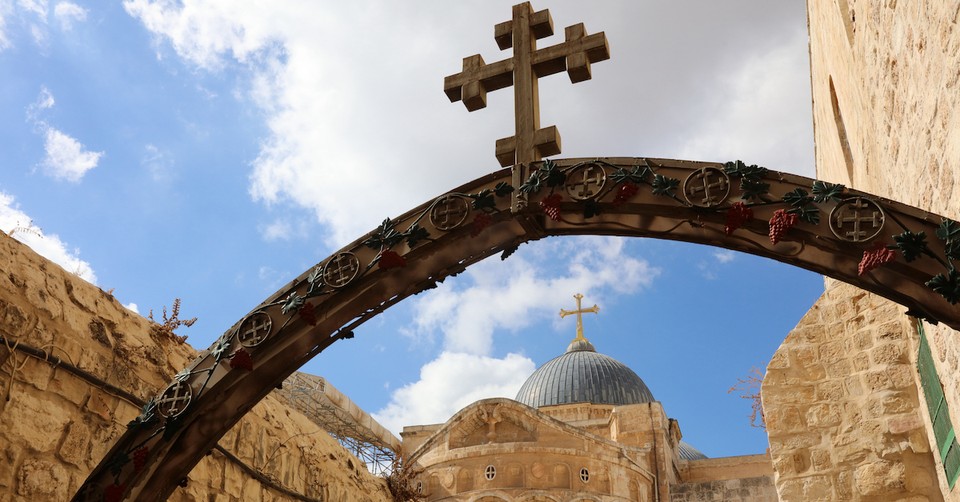What Are the Stations of the Cross and Are They Biblical?

Walking the Stations of the Cross is a traditional and biblically-based practice that originated during the Crusades, at the beginning of the 13th century. Franciscan friars placed the first Stations of the Cross along the Via Dolorosa (“Walk of Sorrow” in Latin) in Old Jerusalem. The Franciscans believed that Christians should remember the faithfulness of Jesus in His final day on earth by walking the Stations of the Cross as spiritual pilgrims. Due to the somber and powerful nature of this religious practice, walking the Stations of the Cross is practiced worldwide on Good Friday, leading to the observation of the glorious resurrection of Christ on Easter. The walk gives Christians a time and place to pause and reflect on Christ’s suffering before His victory over death.
Get your FREE Holy Week Guide Here. Receive encouragement straight to your inbox.
What Are the Stations of the Cross and Are They Biblical?
Eight of the 14 scenes represented by the Stations of the Cross are based on events from the Gospel narratives of Jesus’ last hours on earth. The eight biblically referenced events depicted in the Stations of the Cross are described in the Synoptic Gospels of Matthew, Mark, and Luke. Five of the events in the Stations of the Cross appear in all four of the Gospel books of the Bible. These eight biblically referenced Stations of the Cross are:
Jesus is given the death sentence of crucifixion
Simon of Cyrene carries the cross for Jesus
Righteous women wail and weep as they follow Jesus
Jesus’ clothes are removed
Jesus is nailed to the cross
Jesus dies on the cross
Jesus is taken off the cross
Jesus is buried in a tomb donated by Joseph of Arimathea
The other six Stations of the Cross are based on a religious tradition developed by the Roman Catholic church since the founding of the stations in the early 13th century.
A pilgrim walking the Stations of the Cross proceeds through the series of stops before artwork. pausing to contemplate and pray next to each depiction of an episode in Jesus’ last hours on earth. The stations I have walked had murals carved in stone on the two sides of a sanctuary. There is a wide variety of styles, forms, and placement of the artwork in Stations of the Cross, however, from a simple cross to ornate murals or stone carvings.
The Smithsonian American Art Museum in Washington has an incredible display of artwork in its Stations of the Cross exhibit, representing the sorrow and suffering of Christ and, through Him, many other paths of sorrow traveled by people in America’s history. Migrant workers, soldiers, prisoners, victims of racial discrimination and violence, the poor and the homeless, the grieving, and the mentally ill are part of images in paintings, sculptures, and mixed media works that bear witness to human suffering at the Smithsonian American Art Museum.
Western Christian churches, including Anglican, Lutheran, Methodist, and Roman Catholic, commonly have Stations of the Cross flanking the sides of their sanctuaries or in a separate chapel. Typical stations are small plaques with wooden or stone reliefs or paintings placed around the central part of the church building. Modern, minimalist Stations of the Cross have simple crosses with numbers on them. The pope leads the stations of the cross around the Colosseum in Rome on Good Friday without any visual aids. However, they are represented, the Stations of the Cross are positioned in order from one to 14, true to how final events in Jesus’ life unfolded on what Christians now call Good Friday
The first nine Stations of the Cross represent Jesus on the way to the crucifixion site on the hill of Golgotha:
Jesus is condemned to death.
The cross is laid on Jesus for him to carry.
Jesus falls over while carrying the cross.
Jesus meets his mother, Mary.
Simon of Cyrene is ordered to help Jesus carry the cross.
A woman named Veronica wipes Christ’s face.
Jesus falls a second time.
The women of Jerusalem weep over Jesus.
Jesus falls a third time.
The last five stations of the cross take place at the cross:
Jesus reaches the crucifixion site and is stripped of His clothes.
Jesus is nailed to the cross.
Jesus dies on the cross.
Jesus’ body is removed from the cross.
Jesus is laid in the tomb.
Where Can We Find Them in the Bible?
These are the Bible references that support the stations of the cross:
In the first Station of the Cross, Jesus is given the death sentence by crucifixion. Pontius Pilot deals out the punishment at the urging of an angry mob.
"What shall I do, then, with Jesus who is called Christ?" Pilate asked. They all answered, "Crucify him!" "Why? What crime has he committed?" asked Pilate. But they shouted all the louder, "Crucify him!" (Matthew 27:22-23).
In the second Station of the Cross, authorities force Simon of Cyrene to help carry the cross of Jesus: So the soldiers took charge of Jesus. Carrying his own cross, he went out to the place of the Skull which in Aramaic is called Golgotha (John 19: 15b- 17).
The third Station of the Cross is a traditional site. There are not any scriptures that reference Jesus falling on the way to the cross, although this event was certainly possible and pilgrims experiencing and contemplating the third station are edified.
The fourth Station of the Cross illustrates when Simeon blessed them and said to Mary, his mother: "This child is destined to cause the falling and rising of many in Israel, and to be a sign that will be spoken against, so that the thoughts of many hearts will be revealed. And a sword will pierce your own soul too" (Luke 2:21-22, 25, 34-35).
The fifth Station of the Cross has Simon of Cyrene taking up the cross: A certain man from Cyrene, Simon, the father of Alexander and Rufus, was passing by on his way in from the country, and they forced him to carry the cross (Mark 15:21).
The sixth Station of the Cross, which depicts a woman named Veronica wiping the face of Jesus, is a traditional station.
In the seventh Station of the Cross, Jesus falls a second time. This is another traditional station allowing Christians to contemplate Christ’s pain and suffering.
In the eighth Station of the Cross, Jesus meets the holy women of Jerusalem: Jesus turned and said to them, "Daughters of Jerusalem, do not weep for me; weep for yourselves and for your children" (Luke 23:28).
The ninth Station of the Cross is another traditional one, in which Jesus falls for the third and last time before reaching the cross on the hill of Golgotha.
In the 10th Station of the Cross, Jesus is stripped of His garments: When the soldiers crucified Jesus, they took his clothes, dividing them into four shares, one for each of them, with the undergarment remaining. This garment was seamless, woven in one piece from top to bottom (John 19:23).
In the 11th Station of the Cross, Jesus is nailed to the cross: It was the third hour when they crucified him (Mark 15:25).
In the 12th Station of the Cross, Jesus dies on the cross: It was now about the sixth hour, and darkness came over the whole land until the ninth hour, for the sun stopped shining. And the curtain of the temple was torn in two. Jesus called out with a loud voice, "Father, into your hands I commit my spirit." When he had said this, he breathed his last (Luke 23:44-46).
In the 13th Station of the Cross, Jesus’ body is removed from the cross: As evening approached, there came a rich man from Arimathea, named Joseph, who had himself become a disciple of Jesus. Going to Pilate, he asked for Jesus’ body, and Pilate ordered that it be given to him” (Matthew 27:57-58).
In the 14th and last Station of the Cross, Jesus is placed in the tomb: Joseph of Arimathea, a prominent member of the Council, who was himself waiting for the kingdom of God, went boldly to Pilate and asked for Jesus' body. So Joseph bought some linen cloth, took down the body, wrapped it in the linen, and placed it in a tomb cut out of rock. Then he rolled a stone against the entrance of the tomb (Mark 15:43, 46).
When Did Christians Start Their Pilgrimages of These Stations in Jerusalem?
As mentioned in the introduction, the oldest route of the Stations of the Cross is in Old Jerusalem. Called the Via Dolorosa, or "Way of Suffering" in Latin, the walk begins with the place where Christians have traditionally believed Pilate condemned Jesus to death (the Lion’s Gate near what used to be a Roman fortress) and ends at the tomb where Jesus was buried (the Church of the Holy Sepulchre). The Church of the Holy Sepulchre, originally built in 325 A.D. by Constantine, is a large building containing multiple chapels and levels. This church contains the last five Stations of the Cross.
The first historical reference we have of the Via Dolorosa is from the 13th century. The modern Via Dolorosa with its Stations of the Cross was established in the 1800s and 1900s. It is based on the Bible and Christian traditions that developed almost 2000 years after the lifetime of Jesus. The route has changed somewhat according to interpretations of scholars in modern history, but it is still possible to walk the Via Dolorosa in Old Jerusalem. Tourists who may or may not be religious pilgrims walk the Stations of the Cross on the Via Dolorosa, which is now surrounded by modern buildings.
What Do Christians Need to Know about the Stations of the Cross?
Walking the Stations of the Cross brings Christian pilgrims closer to the life of Christ, particularly the end of the life of Christ. The stations are supported by Gospel narratives on the life of Christ and archaeological finds. An article from Probe Ministries, published by Bible.org, states that the names of many of the Israelite cities, events, and people described in the Gospels have now been located. In the Probe Ministries article, there is an excerpt from the Annals of Tacitus, the Roman historian, who recorded the persecution of Christians in 115 A.D.: “Christus, from whom the name had its origin, suffered the extreme penalty during the reign of Tiberius at the hands of one of our procurators, Pontius Pilatus, and a most mischievous superstition, thus checked for the moment, again broke out not only in Judea…but even in Rome” (Tacitus, Annals, 15.44).
Archeologists continue to discover relics from the days of the early Christian church. Archeological proof, however, may not support Christian’s faith as much as their Gospel-based, spiritual beliefs about Jesus and His mission on Earth.
At the second Station of the Cross, Jesus said, "If anyone would come after me, he must deny himself and take up his cross daily and follow me" (Luke 9:23). Jesus’ cross bore his body and all the sins of the world. Our crosses in life bear the much lighter load of our own sins and shortcomings. Observing the Stations of the Cross, we take on a little of the burden of sin and appreciate the enormous burden Christ took to the cross for us.
Further Reading
What Are the Stations of the Cross and What Can We Learn from Them?
Photo credit: ©GettyImages/ Bernhard Richter

This article is part of our larger Holy Week and Easter resource library centered around the events leading up to the death and resurrection of Jesus Christ. We hope these articles help you understand the meaning and story behind important Christian holidays and dates and encourage you as you take time to reflect on all that God has done for us through his son Jesus Christ!
What is Lent? It's Meaning and Why We Celebrate
When is Lent? When Does Lent Start and End?
What is the Meaning Ash Wednesday?
What is Holy Week?
What Is the Meaning of Palm Sunday?
What is the Meaning of Holy Monday?
What is Maundy Thursday?
What Is Good Friday and Why is it Good?
Good Friday Prayer
What Does Holy Saturday Mean?
What Is the Easter?
Easter Prayers
Powerful Facts About the Cross of Jesus
Originally published February 15, 2024.





